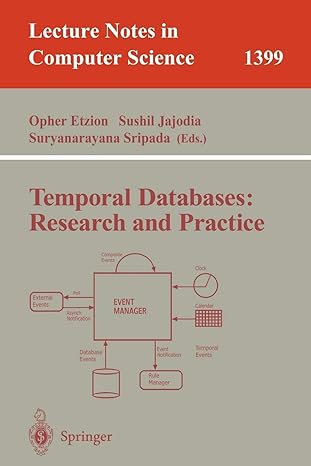Question
*********************************************this is c++ program********************************************* A set of numbers is a unique set of numbers if and only if no number appears more than once in
*********************************************this is c++ program*********************************************
A set of numbers is a unique set of numbers if and only if no number appears more than once in the set.
{1, 6, 9, 3, 2} is a unique set of numbers
{2, 6, 9, 3, 2} is not a unique set of numbers
The two programs simulate LOTTO by generating unique sets of random numbers until the last set equals the first set. Because ordered set comparison is much faster than unordered set comparison, one program sorts the numbers in a set before it compares pairs of sets. However, sorting the sets takes time too. Which program is faster? Is sort time+ search time with sorting less than search time without sorting?
**********************************************************************************
//lotterysimulation1.cpp
#include
#include
#include
#include
#include
#include
using namespace std;
vector
bool kEqual(const vector
size_t gamble(const vector
int main()
{
size_t ubound = 20;
for (size_t counter = 1; counter <= ubound; counter++)
{
vector
cout << setw(2) << counter << ": " << gamble(v, counter, ubound) << endl;
}
system("pause");
return 0;
}
vector
{
uniform_int_distribution
static default_random_engine e((unsigned)time(nullptr));
vector
for (size_t i = 0; i < m; i++)
{
size_t value;
while (find(v.begin(), v.end(), (value = u(e))) != v.end())
;
v[i] = value;
}
return v;
}
bool kEqual(const vector
{
size_t size1 = v1.size();
size_t size2 = v2.size();
size_t count = 0;
for (size_t m1 : v1)
for (size_t m2 : v2)
if (m1 == m2) ++count;
return count >= k;
}
size_t gamble(const vector
{
size_t compares = 0;
vector
do
{
selection = uniqueRandomFill(m, n);
compares++;
} while (!kEqual(original, selection, m));
return compares;
}
**********************************************************************************
//lotterysimulation2.cpp
#include
#include
#include
#include
#include
#include
using namespace std;
vector
bool kEqual(const vector
size_t gamble(const vector
int main()
{
size_t ubound = 20;
size_t fwidth = 2;
for (size_t counter = 1; counter <= ubound; counter++)
{
vector
cout << setw(fwidth) << counter << ": " << setw(6) << gamble(v, counter, ubound) << endl;
}
system("pause");
return 0;
}
vector
{
uniform_int_distribution
static default_random_engine e((unsigned)time(nullptr));
vector
for (size_t i = 0; i < m; i++)
{
size_t value;
while (find(v.begin(), v.end(), (value = u(e))) != v.end())
;
v[i] = value;
}
sort(v.begin(), v.end());
return v;
}
bool kEqual(const vector
{
size_t size1 = v1.size();
size_t size2 = v2.size();
size_t count = 0;
size_t idx1 = 0;
size_t idx2 = 0;
while (idx1 < size1 && idx2 < size2 && k + idx1 <= size1 + count && k + idx2 <= size2 + count)
{
if (v1[idx1] < v2[idx2]) ++idx1;
else if (v2[idx2] < v1[idx1]) ++idx2;
else if (v1[idx1] == v2[idx2])
{
++idx1;
++idx2;
++count;
}
}
return k <= count;
}
size_t gamble(const vector
{
size_t compares = 0;
vector
do
{
selection = uniqueRandomFill(m, n);
compares++;
} while (!kEqual(original, selection, m));
return compares;
}
Step by Step Solution
There are 3 Steps involved in it
Step: 1

Get Instant Access to Expert-Tailored Solutions
See step-by-step solutions with expert insights and AI powered tools for academic success
Step: 2

Step: 3

Ace Your Homework with AI
Get the answers you need in no time with our AI-driven, step-by-step assistance
Get Started


